Published
on 10
Mar 2020
|
All rights reserved.
|
|
|
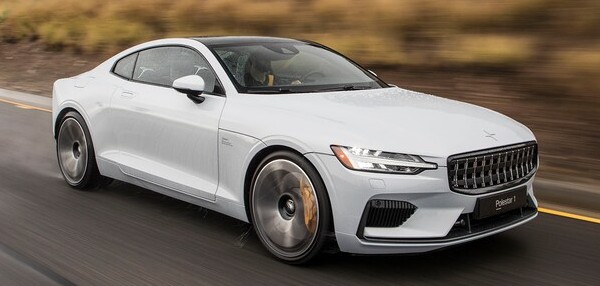
|
|
Polestar's
first car is also the last car with a combustion engine.
|
|
Interesting. I haven't
expected the next generation Volvo C70 or the first S90 Coupe to be
like this. No, this is neither of them but the first dedicated model
developed by and branded as Polestar. The story could wind back to 7
years ago when Volvo unveiled the impossibly beautiful Volvo Concept
Coupe. That car was so great that it inspired not only the current S90
but also the desire of Volvo's management to put it into production.
Somehow, as development unfolded, Volvo found it too good to be badged
as an S90 Coupe or C70 Mk3. Its T8 plug-in hybrid powertrain produced
way more power than the version on S90 T8, so only one badge is
suitable: Polestar.
You know what Polestar is. Once an independent racing team, Polestar
became the official motorsport partner of Volvo, then its official
tuner and eventually acquired by Volvo in 2015. Since then it has been
Volvo's AMG, developing and building high-performance models like S60
and V60 Polestar. Now following the birth of Polestar 1, the
performance division is assigned a new direction: electric performance.
Volvo's parent company Geely wants Polestar to lead the electrification
technology of the group, so Geely and Volvo pumped money to form a
joint-venture in Chengdu, China, dedicated to develop and build the
electric vehicles for Polestar. The Polestar 1 is just the forerunner
of the plan. Ironically, it is also the only Polestar car to have an
engine, because the next Polestar 2 and Polestar 3 will be pure
electric cars.
Unfortunately, this means the Polestar 1 coupe will be built in China.
If Volvo sells it in conventional ways, I'm afraid it could be a very
difficult business case, because the car costs as much as
£139,000 or USD156,000, more than a Mercedes-AMG S63 Coupe!
Therefore, Volvo has its production limited to 500 cars a year, and a
total of only 1500 cars over its lifespan. It also planned to offer it
on subscription basis. However, as the car went through prototype
development phase and was offered motoring journalists to test drive,
reputation built up quickly. Eventually, Volvo felt confident to sell
all the cars it can build, so it cancelled the subscription plan.
Instead, customers can order the car through its online store, which is
a slick experience as there are only a few options, because the
production car is very well equipped in standard.
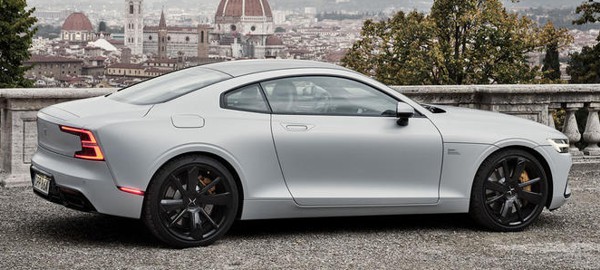
|
|
As
many all-time great designs proved, good design never ages.
|
|
So what is the Polestar 1? It is a luxury 2+2 coupe built upon a
shortened and strengthened version of Volvo SPA platform. Compared with
an S90, it is 378mm shorter and runs a 200mm shorter wheelbase. While
the floorpan is primarily made of steel, it adds a carbon-fiber
transmission tunnel to enhance rigidity, like BMW 7-Series, Lamborghini
Huracan and Audi R8. As a result, torsional rigidity is boosted by 45
percent to 32,000 Nm/degree. The body work is made mostly from
carbon-fiber reinforced plastic – not necessarily cost ineffective, as
steel stamping is expensive for low-volume production – including
bonnet, boot lid, doors and even some structural parts like cross
sections of the roof. Overall, Volvo said the carbon-fiber parts save
230 kg while lowering center of gravity.
The car’s exterior design stays true to the 2013 concept. As many
all-time great designs proved, good design never ages. The coupe is the
best example of Scandinavian design. It is clean, simple and tidy,
understated yet elegant. There are no nonsense curves or twist or big
pseudo intakes or fake diffusers. Every form facilitates function. It
might look a bit bland in pictures, but in the real world it has true
presence, easily besting any BMW or Audi.
Inside, the cabin carries over pretty much everything of S90, which is
actually good. It feels high-quality, user-friendly and inviting. Maybe
not as luxurious as a Mercedes or Bentley or something costing this
much, but it is still a good place to spend time. The front seats
impossibly comfortable, just as you would expect from Volvo. The
touchscreen large and its graphics crisped. The cabin design is
coherent. The standard panoramic roof gives an airy ambience – although
the lack of electronic translucent shading might make it hot under
California sunshine. Nappa stitched leather, smart yellow seat belts,
crystal shift knob and satin-finished carbon inserts inject the
necessary sense of occasion without deviating from Scandinavian taste.
The only true weakness is the cramped rear seats. Short of both leg and
head room, they are about as spacious as that of the 911, which means
child seat at best, luggage space more often.
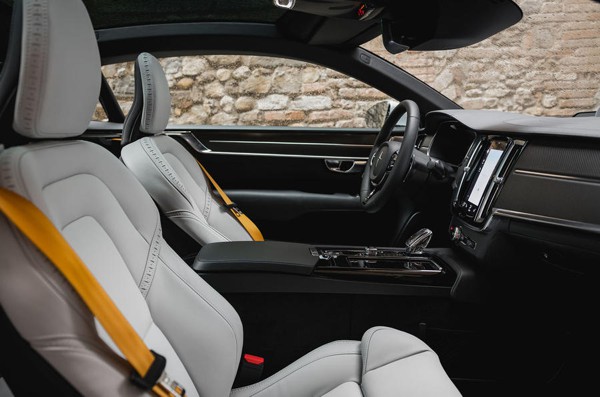
|
|
Cabin design
has sense of occasion without deviating from Scandinavian taste.
|
|
Yes, you do need that luggage space very often, because the boot of
Polestar carries only 143 liters, barely more than the front boot of
911. A Bentley Continental GT swallows 358 liters, while Mercedes
S-class Coupe tops 400 liters.
The small boot is due to the installation of battery. Remember,
although SPA was designed with plug-in hybrid power in mind, it was
tailored to the long-serving Volvo “Twin-Engine” concept rather than a
skateboard electric vehicle platform. Therefore, it places one large
battery pack inside the very tall transmission tunnel and another big
chunk of battery between the rear wheels, eating into the luggage
space. The latter sits above the rear-axle motors, improving weight
distribution to 48:52 front to rear. Although center of gravity is not
as low as that of a typical skateboard EV, that lightweight upper body
helps, thus should still undercut conventional cars.
The hybrid powertrain is similar to the existing T8 "Twin-Engine". Up
front is the supercharged and turbocharged 2.0 Drive-E four-banger
driving exclusively the front axle through an Aisin 8-speed automatic.
It produces more than 300hp and 300 lbft of torque (US and Europe data
vary, so I am not quoting the exact figures here). The engine is
assisted with an integrated starter generator which produces 71 hp and
119 lbft. At the rear axle, a subframe holds 2 electric motors and a
planetary gearset each. These motors are much stronger than those on
the S90 T8 or XC90 T8, producing a combined 232 hp instead of 88 hp,
and doubling torque to 354 lbft. They enable torque vectoring between
the rear wheels, too, which is one of the reasons why electrification
becoming so interesting to performance brands these days. Overall, the
system output is said to be over 600 hp and 737 lbft (1000 Nm). It has
the measure of Bentley Continental GT W12 and Mercedes-AMG S63 Coupe in
terms of output, and even beats them on torque.
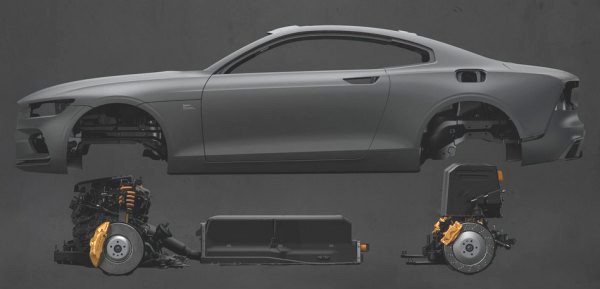
|
|
A large chunk
of battery at the rear axle improves balance but eats into luggage
space seriously.
|
|
But the Volvo coupe is heavy. Very heavy indeed, especially for a coupe
this compact. At 2350 kg, it is heavier than the big Bentley and
Mercedes. Blame must go to the twin-engine design as well as the 34kWh
battery – five times that of a BMW i8. By the way, the latter
comparison would be interesting, as both the i8 and Polestar 1 are
plug-in hybrid 2+2 coupes with carbon-fiber construction and similar
performance, but the BMW is more than 800 kg lighter! Apart from 6
years separating them, the Volvo, sorry, Polestar has a very different
philosophy. It is designed to be a fast yet comfortable GT instead of a
fuel-saving sports car. Its 34kWh worth of battery enables a driving
range of 78 miles (125 km) under WLTP cycles or 93 miles (150 km) under
NEDC, long enough for most people’s commuting, and it allows the car to
cruise at 100 mph on electric power alone. The i8’s electric power
sounds like a joke with 23 miles of NEDC range and 40 mph top speed. If
BMW developed the i8 today, I wonder if it would choose the same route
as Polestar.
On the road, the Polestar 1 feels quick, but not quite as quick as
Bentley Continental GT and Mercedes S63 Coupe. It quotes 0-60 mph at
4.1 seconds, and it may dip under the 4-second mark in road test. Even
so, that is some way behind the Mercedes’ 3.4 seconds and Bentley’s 3.6
seconds. Most motoring journalists blame this for the extra weight it
carries, but they overlook one important factor: traction. The Volvo
has an advantage in torque, especially at very low speed where its
on-off-switch-like electric torque comes to shine. However, at full
thrust it has 440 lbft of torque going to its front axle, while a
smaller portion of torque to the rear, which is actually the heavier
side. This means its front tires struggle for traction. Its ECU has to
scale back full thrust to avoid wheel spin, wasting its torque
advantage. Comparatively, rolling acceleration from, say, 30 mph to 100
mph feels stronger, but by then its rivals have taken full advantage of
their better power-to-weight ratio to pull away.
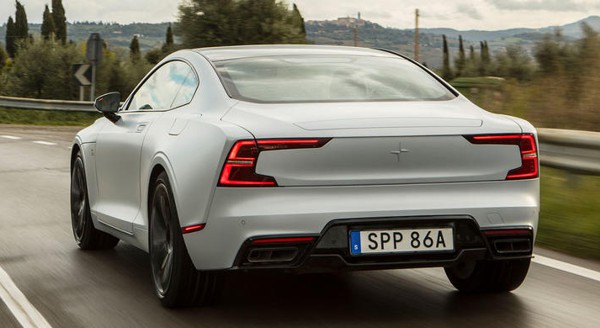 |
|
The Polestar 1
feels quick, but not quite as quick as Bentley and Mercedes.
|
|
Nevertheless, in normal driving this rarely matters. The Polestar still
feels plenty quick for a luxury GT. More remarkably, it is extremely
refined when you drive it at normal speed. In pure electric mode, it
cruises silently, with just a hint of motor whine. All plug-in hybrid
cars do the same, but this one can work up to 100 mph and for a
respectable distance with electric power alone, so unless you are on
Autobahn, it can cover the entire journey without firing the combustion
engine once. In Hybrid mode, the engine starts whenever you call for
more power than the electric motors can provide, but the transition is
smooth and refined, thanks to Volvo’s wealth of experience in the
Twin-Engine technology. In Power mode, both power sources work in
tandem to provide maximum thrust. The resulting sound is an orchestra
of motor whine, supercharger whine, turbo spool and induction noise
from the carbon-fiber plenum. It lacks an exhaust roar, let alone pops
and crackles, but that doesn’t stop it from sounding delicious.
However, the most surprising aspect of this car is how slick its
handling is. Its suspension follows S90 to feature double-wishbones up
front, integral-link and glass-fiber transverse leaf spring at the
rear, but it ditches the luxury car’s air suspension for a set of
Ohlins dual-flow valve adjustable dampers (remark: the
electronic-conrolled
Ohlins CESi dampers featured on the prototype did not get into
production). They can be adjusted with tools in garage, but the factory
setting is probably the best balance for road use. They give the car
superb body control, with precious little body roll and pitch in
corner, which is an achievement for a car this heavy. On the downside,
the ride is firm, especially on low-speed rough roads where shocks can
be transmitted through the chassis and seat cushions to your teeth.
Most of the blame must go to the ultra-low sidewall, 275/30ZR21 and
295/30ZR21 tires. It is not going to be as comfortable as the
air-suspended Bentley and Mercedes for sure, though this is not
necessarily inappropriate for a car badged Polestar. On smoother roads,
the car rides superbly, though tire noise is on the high side.
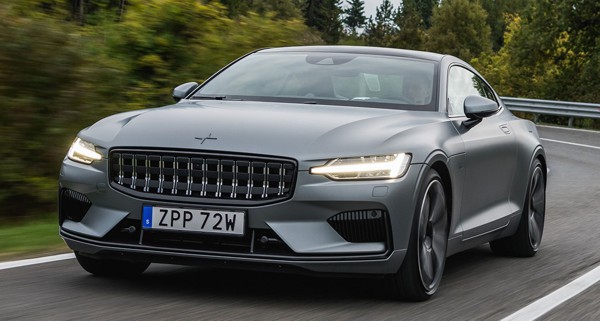
|
|
It steers with
incredible accuracy and corners with an amazing lightness.
|
|
Although the steering is not renowned for feel, just like any Volvos,
this one is accurate and well-weighted to give you confidence. Torque
steer is not entirely absent, but rarely bother. Most impressive is the
work of the rear motors, as they sharpen the turn-in response and kill
understeer to the extent that you will forget about driving a 2.3-ton
car. We are not saying the agility of a sports car, but it has the big
Bentley and AMG beaten. It steers with incredible accuracy and corners
with an amazing lightness. No, it isn’t tuned to play sideway games
like its rivals can do, but that is just the choice of Polestar. While
it offers many driving modes, none of those are labelled “Drift”, as it
always chases neutral and precision in its highest order. It just grips
hard with its fat P Zero tires, brakes hard with its powerful brakes.
The front brakes consist of 400mm ventilated drilled discs and aluminum
monobloc 6-piston calipers supplied by Akebono, which supplied also
McLaren P1. The rears are 391mm discs and 4-pot calipers. They blend
mechanical and regenerative braking very well, with just a hint of low
speed snatchiness.
The best way to enjoy the Polestar 1 is not full-bore attack, because
after all it has a lot of weight and too much torque for even those fat
tires to handle. Instead, it feels best to drive at lower paces, as you
will enjoy its instant torque, superb refinement and at the same time
the accurate turn-in and flat body control, all achievable without
raising your pulse. It does the job of luxury GT very well, although
the poor low-speed ride, tiny rear seat and laughable boot might say
otherwise. The 1 is beautiful and full of character. As a plug-in
hybrid, it is also trendy. However, it is neither as sporty and
emotional as an Aston Martin DB11, nor as exquisitely built and
luxurious as Bentley Continental GT, is it worth that much money? That
depends on your view, but considering its rarity and the fact that it
is Polestar first and last car with a combustion engine, it is probably
worth the money.
|
Verdict:     |
|